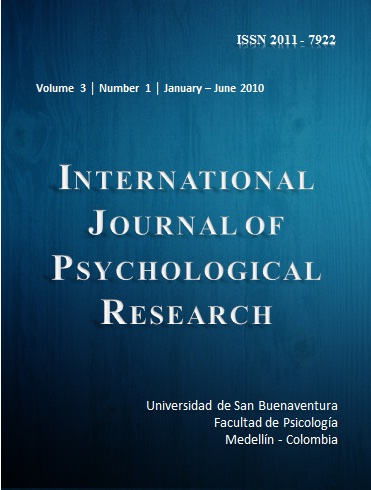How to Cite
Cousineau, D., & Chartier, S. (2010). Outliers detection and treatment: a review. International Journal of Psychological Research, 3(1), 58–67. https://doi.org/10.21500/20112084.844
More Citation Formats
License terms
▼
The work that is sent to this journal must be original, not published or sent to be published elsewhere; and if it is accepted for publication, authors will agree to transfer copyright to International Journal of Psychological Research.
To give up copyright, the authors allow that, International Journal of Psychological Research, distribute the work more broadly, check for the reuse by others and take care of the necessary procedures for the registration and administration of copyright; at the same time, our editorial board represents the interests of the author and allows authors to re-use his work in various forms. In response to the above, authors transfer copyright to the journal, International Journal of Psychological Research. This transfer does not imply other rights which are not those of authorship (for example those that concern about patents). Likewise, preserves the authors rights to use the work integral or partially in lectures, books and courses, as well as make copies for educational purposes. Finally, the authors may use freely the tables and figures in its future work, wherever make explicit reference to the previous publication in International Journal of Psychological Research. The assignment of copyright includes both virtual rights and forms of the article to allow the editorial to disseminate the work in the manner which it deems appropriate.
The editorial board reserves the right of amendments deemed necessary in the application of the rules of publication.
To give up copyright, the authors allow that, International Journal of Psychological Research, distribute the work more broadly, check for the reuse by others and take care of the necessary procedures for the registration and administration of copyright; at the same time, our editorial board represents the interests of the author and allows authors to re-use his work in various forms. In response to the above, authors transfer copyright to the journal, International Journal of Psychological Research. This transfer does not imply other rights which are not those of authorship (for example those that concern about patents). Likewise, preserves the authors rights to use the work integral or partially in lectures, books and courses, as well as make copies for educational purposes. Finally, the authors may use freely the tables and figures in its future work, wherever make explicit reference to the previous publication in International Journal of Psychological Research. The assignment of copyright includes both virtual rights and forms of the article to allow the editorial to disseminate the work in the manner which it deems appropriate.
The editorial board reserves the right of amendments deemed necessary in the application of the rules of publication.
Abstract
Outliers are observations or measures that are suspicious because they are much smaller or much larger than the vast majority of the observations. These observations are problematic because they may not be caused by the mental process under scrutiny or may not reflect the ability under examination. The problem is that a few outliers is sometimes enough to distort the group results (by altering the mean performance, by increasing variability, etc.). In this paper, various techniques aimed at detecting potential outliers are reviewed. These techniques are subdivided into two classes, the ones regarding univariate data and those addressing multivariate data. Within these two classes, we consider the cases where the population distribution is known to be normal, the population is not normal but known, or the population is unknown. Recommendations will be put forward in each case.
Keywords:
References
Bamber, D. (1969). Reaction times and error rates for "same"-"different" judgments of multidimensional stimuli. Perception and Psychophysics, 6, 169-174.
Belsley, D. A., Kuh, E., & Welsch, R. E. (1980). Regression diagnostics : identifying influential data and sources of collinearity. Wiley series in probability and mathematical statistics. New York: John Wiley & Sons.
Cook, R. D. (1977). Detection of influatial observation in linear regression. Technometrics, 19, 15-18. Cousineau, D., & Shiffrin, R. M. (2004). Termination of a visual search with large display size effect. Spatial Vision, 17, 327-352.
Belsley, D. A., Kuh, E., & Welsch, R. E. (1980). Regression diagnostics : identifying influential data and sources of collinearity. Wiley series in probability and mathematical statistics. New York: John Wiley & Sons.
Cook, R. D. (1977). Detection of influatial observation in linear regression. Technometrics, 19, 15-18. Cousineau, D., & Shiffrin, R. M. (2004). Termination of a visual search with large display size effect. Spatial Vision, 17, 327-352.
Downloads
Download data is not yet available.


































